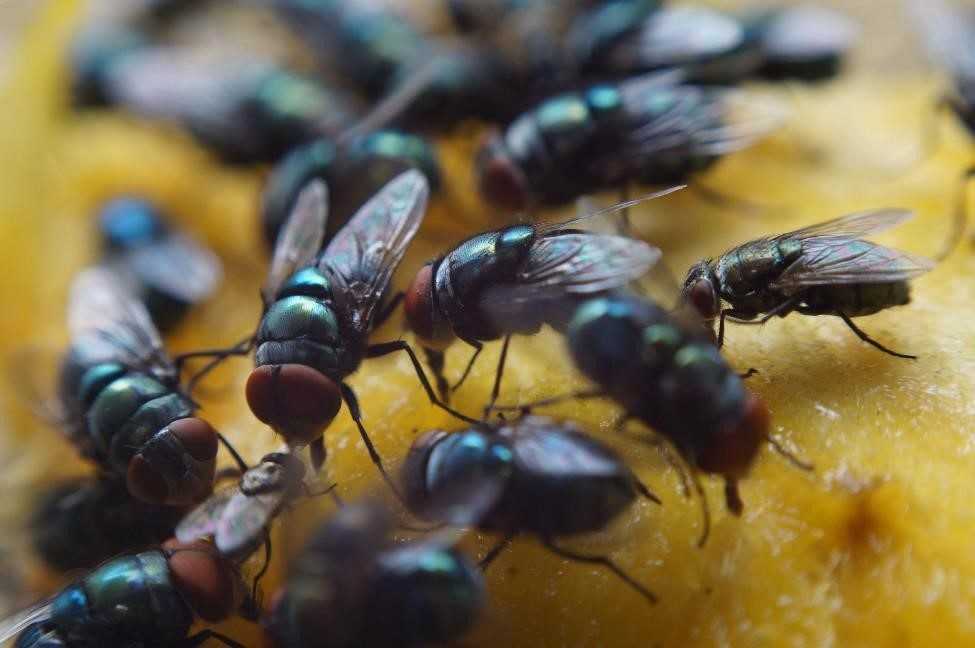With over 16,000 species of flies in North America, we see them almost everywhere we go. Whether they are swarming you outside or invading your house, they are a problem all year, significantly more in the warmer months. Certain smells and the presence of decaying organic matter can attract flies to homes, making them a persistent issue. That problem: flies!
At PURCOR Pest Solutions, we create a customized solution for your household to attack any fly troubles you may come across. Our approach focuses on leaving you with a fly-free home while making sure you are protected from any unnecessary chemicals. Let’s cover why there may be flies in your house and a few types of flies you can expect to see welcoming themselves into your home. We will also talk about how to get rid of them with PURCOR.
Understanding Fly Behavior and Life Cycle
Flies are fascinating creatures with complex behaviors and life cycles that play a crucial role in their ability to infest homes. Understanding these aspects can help you manage and prevent fly infestations more effectively. Flies undergo a complete metamorphosis, which includes four stages: egg, larva, pupa, and adult.
The life cycle begins when a female fly lays her eggs in a suitable location, such as garbage cans, decaying matter, or animal waste. These eggs hatch into larvae, commonly known as maggots, which feed on the surrounding material to grow. After a period of feeding, the larvae enter the pupal stage, during which they transform into adult flies. Once they emerge, adult flies feed on nectar, sugary substances, and other organic matter. Depending on the species, adult flies can live for several weeks to a few months, during which they continue to reproduce and lay eggs, perpetuating the cycle.
Identifying the Type of Fly
Identifying the type of fly invading your home is essential for determining the most effective control measures. While there are over 16,000 species of flies in North America, only a few are common household pests. The most prevalent types include house flies, fruit flies, cluster flies, and drain flies.
House flies are grayish-black with four distinct black stripes on their thorax. They are often found around garbage cans and decaying organic matter. Fruit flies, on the other hand, are smaller and have distinctive red or yellow eyes. They are typically attracted to ripe or rotting fruit and vegetables. Cluster flies are larger and darker than house flies, with a more robust body, and they tend to gather in large numbers, especially in attics and wall voids. Drain flies are small, hairy, and have a moth-like appearance. They are usually found near stagnant water and organic buildup in drains.
How Do House Flies Get Into Your House?
Doors and Windows Are Left Open
Being a homeowner comes with many responsibilities and making sure everything is functioning properly. When you have a large family, things can get chaotic, resulting in doors and windows left open without your knowledge. They also get left open when you want some fresh air. This may seem like an obvious reason flies can enter your home, but a lot of people don’t realize how many flies can come through these open windows and doors because they are attracted to everything inside your home. Once inside, flies can lay numerous fly eggs, which hatch quickly and contribute to the infestation. It becomes a secluded area for all these flies to multiply and spread their diseases.
It is therefore key to be sure you are closing all windows and doors. If you are someone who enjoys having their windows and doors open, you can invest in getting screens for protection from not only flies but all pests.
Ripped Screens, Unsealed Cracks, and Holes
Sometimes, even when screens cover our windows and doors, flies can find their way through tiny crevices to get to anything they’re sensing in your home. Dead animals can also attract flies, as they lay their eggs on decomposing matter. Screens can have rips, holes, and unsealed cracks between the frame and the screen. Flies also come in through openings around plumbing and pipes, vents, and cracks in the foundation.
If you have holes in your air conditioner filters or cracks around the unit, flies can come through without you even knowing. The roof of your home is another hidden way for flies to enter your home because there may be holes or damaged ceilings you are unaware of. It is important to be aware of these possibilities because the older the house is, the more common it is.
Poor Sanitation and Garbage Cans
One main reason flies end up in your home in the first place is because of poor sanitation, which is a primary cause of fly infestation. Flies are known to gather around garbage cans, spoiled food, and dirty, unsanitary areas. They love to live and breed in filth, so the dirtier and unsanitized your house is, the more likely flies will gather in your home.
They thrive in this filthy environment, allowing their numbers to increase, making it more difficult for you to get rid of them. Keeping a clean, sanitized space will prevent flies from multiplying and taking over your home.
Food Left Open and Out

One thing that leads to poor sanitization is food being left out or open. Different fly species are attracted to various types of food, such as fruit flies to ripe fruit and house flies to decaying matter. One type of fly that can enter your home is the fruit fly. If you have ripe, rotting, or decaying fruit and produce, this is the exact environment fruit flies are looking for. Another thing fruit flies are attracted to is fermented items such as liquor and wine. They also are very prone to breeding and developing in drains, garbage disposals, and trash cans.
Once fruit flies enter your home, it becomes difficult to get them to leave. They multiply very quickly, and even when you throw out the food that has gone bad, you will still find them lurking around your kitchen. Once you purchase your produce, it is important to wash it thoroughly and store it in the fridge as soon as possible. When it goes bad, throw it away immediately and be sure anything spilled or leftover is cleaned up.
Stagnant Pools of Water and Buildup Attract Drain Flies
Not many people can distinguish the different types of flies that enter their homes because they assume they are all the same. But they’re not: consider the drain fly. Drain flies are particularly sneaky and are attracted to stagnant pools of water and buildup. Stagnant water provides an ideal environment for fly eggs to hatch and larvae to thrive. This means that drain flies like to feed on and breed in sewage. They like to find dark, moist areas where they can breed and multiply.
You will most likely find drain flies in bathroom and kitchen drains, the shower, sump pumps, sewage systems, and even any floorboards where you might be experiencing a leak of some sort. If you have a water leak, you want to get it taken care of as soon as possible because if it’s left untreated, drain flies are bound to take over.
What Attracts Flies to Your Home
Flies are drawn to a variety of substances and environments, making your home an attractive target if certain conditions are met. House flies are particularly attracted to sweet or fermented substances, such as fruit, soda, and garbage. They thrive in environments where food is left out or garbage cans are not properly sealed.
Fruit flies are notorious for being attracted to ripe or rotting fruit and vegetables, as well as sugary substances like soda and juice. They can quickly become a nuisance in kitchens where produce is not stored properly. Cluster flies are attracted to light, warmth, and food, often seeking shelter in homes during cooler months. Drain flies, on the other hand, are drawn to stagnant water and organic matter, making bathroom and kitchen drains their preferred breeding sites.
Understanding what attracts flies to your home is crucial for preventing future infestations. By eliminating these attractants, you can significantly reduce the likelihood of dealing with so many flies.
Fly-Borne Diseases and Risks
Flies are more than just a nuisance; they are also vectors for various diseases and pathogens. House flies, for instance, can transfer bacteria from feces to food, spreading illnesses such as typhoid, tuberculosis, cholera, and dysentery. Fruit flies, while less harmful, can still contaminate fruit and vegetables with their saliva and feces, posing a risk to your health.
Cluster flies, although less likely to spread diseases compared to house flies, can still be a concern due to their tendency to gather in large numbers. Drain flies, which breed in sewage and decaying matter, can spread diseases through their contact with these unsanitary environments.
Taking measures to prevent fly infestations is essential to reduce the risk of fly-borne diseases. Maintaining a clean and sanitary home environment is the first step in protecting your health.
Keep Flies Out of Your Home With PURCOR Fly Control Services
While there are many ways to prevent flies from entering your home, they’re not always going to be 100% effective. Recognizing different fly species is crucial for implementing effective control measures. Sometimes having a professional help you out is going to protect your home and your family with their service. When you call PURCOR, you can get an inspection set up right away and come up with a customized solution for you and your family. Contact us and request your free fly control estimate today!
Preventing Future Infestations
Preventing future fly infestations requires a comprehensive approach that includes sanitation, exclusion, and fly control measures. Regularly cleaning and disinfecting surfaces, eliminating standing water, and sealing entry points can go a long way in keeping flies at bay.
Using fly traps or repellents can also help reduce the number of flies in your home. Fly traps are particularly effective in capturing adult flies, preventing them from reproducing and laying eggs. Additionally, implementing fly control services, such as those offered by professional pest control companies, can provide effective and long-lasting solutions to fly infestations.
By understanding fly behavior and life cycles, identifying the type of fly, and taking proactive measures to prevent infestations, you can keep your home fly-free and reduce the risk of fly-borne diseases. For a more tailored approach, consider reaching out to PURCOR Pest Solutions for expert advice and services. Contact us today and request your free fly control estimate!
"*" indicates required fields
"*" indicates required fields




